 W
WThe Cyclades are an island group in the Aegean Sea, southeast of mainland Greece and a former administrative prefecture of Greece. They are one of the island groups which constitute the Aegean archipelago. The name refers to the islands around the sacred island of Delos. The largest island of the Cyclades is Naxos, however the most populated one is Syros.
 W
WAegean cats are a naturally occurring landrace of domestic cat originating from the Cycladic Islands of Greece. It is considered a natural cat, developing without human interference. Development of the Aegean cat as a formal breed began in the early 1990s by breeders in the fledgling Greek cat fancy, but the variety has yet to be recognized by any major fancier and breeder organization. It is considered to be the only native Greek variety of cat.
 W
WAmorgos is the easternmost island of the Cyclades island group and the nearest island to the neighboring Dodecanese island group in Greece. Along with 16 neighboring islets, the largest of which is Nikouria Island, it comprises the municipality of Amorgos, which has a land area of 126.346 square kilometres and a population of 1,973.
 W
WAnafi, anciently, Anaphe, is a Greek island community in the Cyclades. In 2011, it had a population of 271. Its land area is 40.370 square kilometres. It lies east of the island of Thíra (Santorini). Anafi is part of the Thira regional unit.
 W
WAnanes is a group of 7 small uninhabited. islets in Greece's Aegean Sea, on the outskirts of the Cyclades island group. They are arranged in a crescent-like shape from southwest to due north, and comprise the south-westernmost islands of the Cyclades. The nearest islands are Milos and Antimilos to the northeast and Falkonera to the northwest.
 W
WAntimilos is a Greek island in the Cyclades, 13 miles northwest of Milos. Administratively, it is part of the municipality of Milos. Antimilos is an uninhabited mass of trachyte, often called Erimomilos. It is a volcanic island and the crater is still obvious. Ancient inhabitants transformed the crater to an open rain tank. On the island lives a rare variation of the common goat called Capra aegagrus pictus. It is similar but not the same as the Cretan goat known as "kri-kri".
 W
WAntiparos is a small island in the southern Aegean, at the heart of the Cyclades, which is less than one nautical mile (1.9 km) from Paros, the port to which it is connected with a local ferry. Saliagos island is the most ancient settlement in the Cyclades, and Despotiko, an uninhabited island in the southwest of Antiparos, is a place of great archaeological importance.
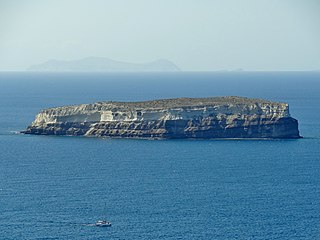 W
WAspronisi is an uninhabited island lying within the Santorini caldera. The island was originally formed by the massive Minoan eruption in the 2nd millennium BC, after which it was gradually built up by successive volcanic activity. The name Aspronisi, which means 'White Island' in Greek, is derived from the island being partially composed of white pumice.
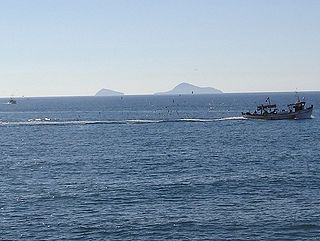 W
WChristiana is a group of three volcanic Greek islands in the Cyclades. The group is located about 10 miles southwest of Santorini and is made up of the islands Christiani, Eschati (Εσχάτη) and Askania (Ασκανιά). The island's area is about 2.35 km². All three islands are now uninhabited but on Christiani there are remains of human settlement dating back to Neolithic times. Christiana islands have been uninhabited since the 1890s and have remained un-farmed since then. As a result, artificial pesticides and fertilizers are absent from this ecosystem. In the mid 1970s, the largest island, Christiani, was considered by NATO as a military base intended to host a missile silo, but this never came to pass. These islands are privately owned and public access is restricted.
 W
WDespotikó, anciently, Prepesinthus or Prepesinthos, is a small, uninhabited Greek island in the Cyclades. It is situated west of the island of Antiparos, and east of the smaller island of Strongyli.
 W
WDwarf elephants are prehistoric members of the order Proboscidea which, through the process of allopatric speciation on islands, evolved much smaller body sizes in comparison with their immediate ancestors. Dwarf elephants are an example of insular dwarfism, the phenomenon whereby large terrestrial vertebrates that colonize islands evolve dwarf forms, a phenomenon attributed to adaptation to resource-poor environments and selection for early maturation and reproduction. Some modern populations of Asian elephants have also undergone size reduction on islands to a lesser degree, resulting in populations of pygmy elephants.
 W
WEschati (Εσχάτη) is a Greek island in the Cyclades.
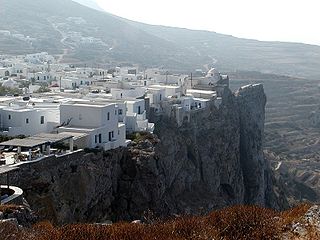 W
WFolegandros is a small Greek island in the Aegean Sea that, together with Sikinos, Ios, Anafi and Santorini, forms the southern part of the Cyclades. Its surface area is 32.216 square kilometres (12.439 sq mi) and it has 765 inhabitants. It has three small villages, Chora, Karavostasis, and Ano Meria, which are connected by a paved road. Folegandros is part of the Thira regional unit.
 W
WThe Grotta-Pelos culture refers to a "cultural" dating system used for part of the early Bronze Age in Greece. Specifically, it is the period that marks the beginning of the so-called Cycladic culture and spans the Neolithic period in the late 4th millennium BC, continuing in the Bronze Age to about 2700 BC. The term was coined by Colin Renfrew, who named it after the sites of Grotta and Pelos on the Cycladic islands of Naxos and Milos, respectively. Other archaeologists prefer a "chronological" dating system and refer to this period as the Early Cycladic I (ECI).
 W
WGyaros, also locally known as Gioura, is an arid and unpopulated Greek island in the northern Cyclades near the islands of Andros and Tinos, with an area of 23 square kilometres (9 sq mi). It is a part of the municipality of Ano Syros, which lies primarily on the island of Syros. This and other small islands of the Aegean Sea served as places of exile for important persons in the early Roman empire. The extremity of its desolation was proverbial among Roman authors, such as Tacitus and Juvenal. It was a place of exile for leftist political dissidents in Greece from 1948 until 1974. At least 22,000 people were exiled or imprisoned on the island during that time. It is an island of great ecological importance as it hosts the largest population of monk seal in the Mediterranean.
 W
WKardiotissa, anciently, Lagusa or Lagousa or Lagussa or Lagoussa (Λαγοῦσσα), is a Greek island in the Cyclades. It is uninhabited and administratively a part of the island community of Sikinos. It lies midway between that island and the island of Folegandros.
 W
WKimolos is a Greek island in the Aegean Sea. It lies on the southwest of the island group of Cyclades, near the bigger island of Milos. Kimolos is the administrative center of the municipality of Kimolos, which also includes the uninhabited islands of Polyaigos, Agios Efstathios and Agios Georgios. The island has a land area of 36 square kilometres (13.900 sq mi), while the municipality's land area is 53.251 square kilometres (20.560 sq mi), and it reported a population of 910 inhabitants in the 2011 census.
 W
WKopanisti is a salty, spicy cheese, with protected designation of origin (PDO) produced in the Greek islands of the Cyclades in the Aegean Sea such as Mykonos, Tinos, Andros, Syros, Naxos etc; it has been produced in Mykonos for more than 300 years. It owes its special peppery and spicy taste to rapid and extensive lipolysis and proteolysis caused by abundant microbial growth encouraged by repeated kneadings performed during the ripening process.
 W
WThe Lesser Cyclades or Small Cyclades is an island complex in the Aegean Sea, inside the archipelago of the Cyclades. It is located to the south-east of Naxos and comprises 32 islands and rocks. The main islands are Ano Koufonisi, Kato Koufonisi, Irakleia, Schoinoussa, Donousa and Keros. The largest of them is Irakleia with an area of 18 km2 and the most populated is Ano Koufonisi with a population of 399, according to the 2011 census. Only four of them are inhabited, Ano Koufonisi, Irakleia, Donousa and Schoinoussa. The islet of Kato Antikeri has also two inhabitants. Administratively, the islands belong to the Naxos and Lesser Cyclades municipality apart from the islets of Ano and Kato Antikeri that belong to Amorgos municipality.
 W
WMilos or Melos is a volcanic Greek island in the Aegean Sea, just north of the Sea of Crete. Milos is the southwesternmost island in the Cyclades group.
 W
WThe Milos wall lizard (Podarcis milensis) is a small Mediterranean lizard.
 W
WNaxos and Lesser Cyclades is a municipality in the Naxos regional unit, South Aegean region, Greece. The seat of the municipality is the town Naxos (city). The municipality consists of the Cycladic island of Naxos and the islands of the Lesser Cyclades: Donousa, Irakleia, Koufonisia, Schoinoussa and several smaller islands. The municipality has an area of 495.867 km2.
 W
WPachia is an uninhabited Greek island in the Cyclades in the south of Anafi.
 W
WPanthiraikos Football Club was a Greek football club based in Santorini, Cyclades.
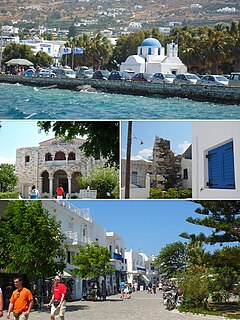 W
WParos is a Greek island in the central Aegean Sea. One of the Cyclades island group, it lies to the west of Naxos, from which it is separated by a channel about 8 kilometres wide. It lies approximately 150 km south-east of Piraeus. The Municipality of Paros includes numerous uninhabited offshore islets totaling 196.308 square kilometres (75.795 sq mi) of land. Its nearest neighbor is the municipality of Antiparos, which lies to its southwest. In ancient Greece, the city-state of Paros was located on the island.
 W
WPhylakopi, located at the northern coast of the island of Milos, is one of the most important Bronze Age settlements in the Aegean and especially in the Cyclades. The importance of Phylakopi is in its continuity throughout the Bronze Age and because of this, it is the type-site for the investigation of several chronological periods of the Aegean Bronze Age.
 W
WThe Phylakopi I culture refers to a "cultural" dating system used for the Cycladic culture that flourished during the early Bronze Age in Greece. It spans the period ca. 2300-2000 BC and was named by Colin Renfrew, after the settlement of Phylakopi on the Cycladic island of Milos. Other archaeologists describe this period as the Early Cycladic III (ECIII).
 W
WPolýaigos is an uninhabited Greek island in the Cyclades near Milos and Kimolos. It is part of the community of Kimolos. Its name means "many goats", since it is inhabited only by goats. It was mentioned by several ancient geographers: Ptolemy, Pliny the Elder, and Pomponius Mela.
 W
WRineia or Rhenea (Ρήνεια), anciently Rheneia or Rhenaia (Ῥηναῖα), or Rhene (Ῥήνη), is a Greek island in the Cyclades. It lies just west of the island of Delos and further southwest of the island of Mykonos, of which it and Delos are administratively a part. Its area is 14 km2 (5 sq mi). It had a small population until the 1980s, but is currently uninhabited. In ancient times the island was subdued by the tyrant Polycrates of Samos and dedicated to the Delian Apollo; and the southern half of the island was the necropolis of Delos. In the sixth year of the Peloponnesian War (426 BCE), the Athenians purified Delos. They removed all the tombs from that island, and declared it to be unlawful henceforth for any living being to be born or die within it, and that every pregnant woman should be carried over to the island of Rheneia in order to be delivered.
 W
WSantorini 2020 Football Club is a Greek football club based in Santorini, Cyclades, Greece.
 W
WSerifopoula is a Greek island in the Cyclades. It is a part of the municipality of Serifos. Serifopoula was uninhabited at the 2001 Greek census. The island is largely barren of vegetation, and consists of a large main island 1.36 square kilometres (0.53 sq mi) in size, and a small rock, separated by a small 19 metres (62 ft) strait to the island's east, 5,130 square metres in size.
 W
WSerifos is a Greek island municipality in the Aegean Sea, located in the western Cyclades, south of Kythnos and northwest of Sifnos. It is part of the Milos regional unit. The area is 75.207 square kilometres (29.038 sq mi) and the population was 1,420 at the 2011 census. It is located about 170 kilometres ESE of the Athenian port of Piraeus.
 W
WSikinos is a Greek island and municipality in the Cyclades. It is located midway between the islands of Ios and Folegandros. Sikinos is part of the Thira regional unit.
 W
WSyros, or Siros or Syra is a Greek island in the Cyclades, in the Aegean Sea. It is located 78 nautical miles (144 km) south-east of Athens. The area of the island is 83.6 km2 (32 sq mi) and it has 21,507 inhabitants.
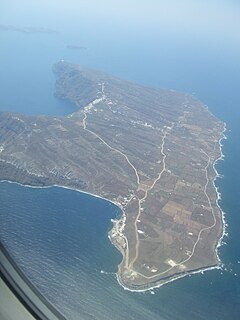 W
WTherasia, also known as Thirasía, is an island in the volcanic island group of Santorini in the Greek Cyclades. It lies north-west of Nea Kameni, a small island formed in recent centuries by volcanic activity and thus marking the centre of the island group. Therasia is the second largest island of the group, the largest by far being Thera.
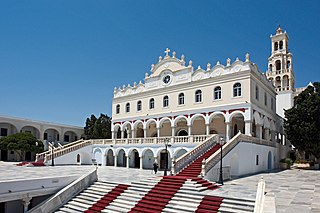 W
WTinos is a Greek island situated in the Aegean Sea. It is located in the Cyclades archipelago. In antiquity, Tinos was also known as Ophiussa and Hydroessa. The closest islands are Andros, Delos, and Mykonos. It has a land area of 194.464 square kilometres (75.083 sq mi) and a 2011 census population of 8,636 inhabitants.
 W
WTomatokeftedes are fried tomato balls served as an appetizer on the Greek island of Santorini, and generally Cyclades. The dish is made from crushed or pureed tomatoes fried in oil. The batter is tomatoes and flour kneaded into a dough along with spices, parsley, onion, and mint; the dough is then fried in cooking oil and served as an appetizer. Santorini-grown tomatoes are preferred, as the island's rugged terrain and pumice-laced soil makes for more robust fruits.
 W
WTsimintiri, also known as Koimitiri, is a small, uninhabited islet in the Cyclades islands of the southern Aegean. Tsimintiri is located between the islands of Antiparos and Despotiko. The strait that separates all three islands is no more than 1 metre (3 ft) deep, so it is believed that the islands were connected as a single landmass in Classical times.
 W
WVous is a small, uninhabited island 2 kilometres off the East coast of Serifos in the Cyclades, Greece. Its name is evocative of the profile of an ox, which it resembles as seen from Sefiros. The island has a perimeter of approximately 2 kilometres and its greatest length is approximately 570 metres. The island is a popular fishing spot. Administratively, it is part of the municipality of Serifos.